
Château de Versailles
Trianon Palaces and Domaine de Marie-Antoinette
Map: Domaine de Marie-Antoinette
Map: Versailles Town Hotels & Restaurants
Every king’s dream, Versailles (vehr-“sigh”) was the residence of French monarchs and the cultural heartbeat of Europe for about 100 years—until the Revolution of 1789 changed all that. The Sun King (Louis XIV) created Versailles, spending freely from the public treasury to turn his dad’s hunting lodge into a palace fit for the gods (among whom he counted himself). Louis XV and Louis XVI spent much of the 18th century gilding Louis XIV’s lily. In 1837, about 50 years after the royal family was evicted by citizen-protesters, King Louis-Philippe (then a constitutional monarch rather than a divine one) opened the palace as a museum. Today you can visit parts of the huge palace and wander through acres of manicured gardens sprinkled with fountains and studded with statues. Europe’s next-best palaces are just Versailles wannabes.
Worth ▲▲▲, Versailles offers three blockbuster sights. The main attraction is the palace itself, called the Château. Here you walk through dozens of lavish, chandeliered rooms once inhabited by Louis XIV and his successors. Next come the expansive Gardens behind the palace, a landscaped wonderland crossed with footpaths and dotted with statues and fountains. Finally, at the far end of the Gardens, is the pastoral area called the Trianon Palaces and Domaine de Marie-Antoinette (a.k.a. Trianon/Domaine), designed for frolicking blue bloods and featuring several small palaces and Marie’s Hamlet—perfect for getting away from the mobs at the Château.
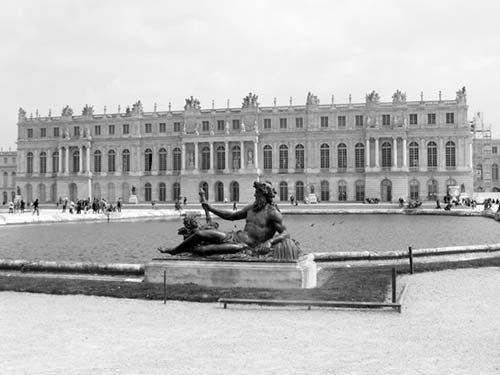
Visiting Versailles can seem daunting because of its size and hordes of visitors. But if you follow my tips, a trip here during even the busiest times is manageable.

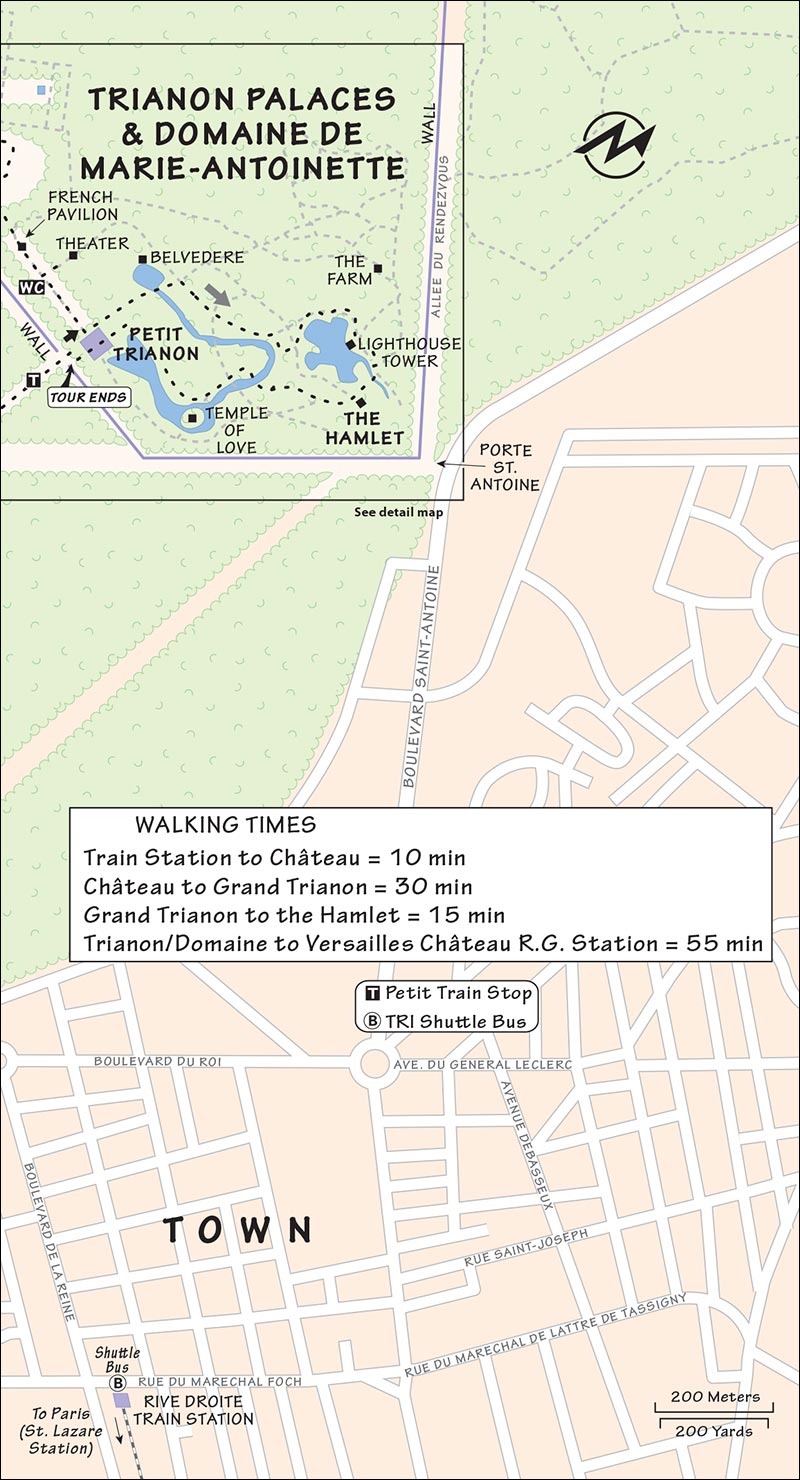

By Train: The town of Versailles is 35 minutes southwest of Paris. Take Train-C from any of these Paris suburban train stops: Gare d’Austerlitz, St. Michel, Musée d’Orsay, Invalides, Pont de l’Alma, or Champ de Mars. Buy your round-trip ticket—ask for “Versailles Château, aller-retour (ah-lay ruh-toor)”—from a ticket window or from an easy-to-figure-out ticket machine (€7.10 round-trip, credit card or coins, 4/hour). To save a little money, you can buy Train-C tickets to Versailles at any Métro ticket window in Paris—your ticket will include the connection from that Métro stop to the suburban train stop at no extra cost. Catch any train listed as “Versailles Château Rive Gauche.” Departure boards indicate when the next trains depart and from which track.
Board your train and relax. On all Versailles-bound trains, Versailles Château Rive Gauche is the final stop. Once you arrive, exit through the turnstiles (you may need to insert your ticket). To reach the Château, follow the flow: Turn right out of the station, then left at the first boulevard, and walk 10 minutes.
Returning to Paris: At the Versailles Château Rive Gauche train station, the monitor above the ticket turnstiles shows how many minutes until the next train leaves and from which track. To get back into Paris, just hop on the next train—all trains departing this station zip back to the city, stopping at all stations along line C. And remember, your Train-C ticket covers you on any connecting Métro ride once you’re back downtown.
By Taxi: The 30-minute ride (without traffic) between Versailles and Paris costs about €60.
By Car: Get on the périphérique freeway that circles Paris, and take the toll-free A-13 autoroute toward Rouen. Exit at Versailles, follow signs to Versailles Château, and avoid the hectic Garden lots by parking in the big pay lot at the foot of the Château on Place d’Armes (€4/hour).
Versailles is all about crowd management; a well-planned visit can make or break your experience. Take this advice to heart.
Versailles merits a full sightseeing day and is much more enjoyable with a relaxed, unhurried approach. Here’s what I’d do on a first visit:
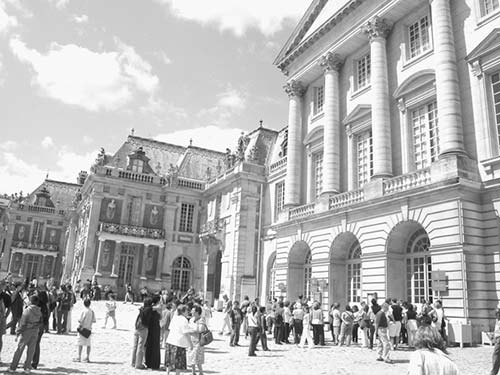
• Get a pass in advance (explained later, under “Passes”).
• In high season, avoid Sundays, Tuesdays, and Saturdays (in that order), when crowds smother the palace interior. Thursdays and Fridays are the best days to visit.
• Leave Paris by 8:15 and arrive at the palace as it opens at 9 (or leave earlier and have the €10.50 buffet breakfast at the Hôtel Ibis across from Versailles’ train station—see here).
• In the morning, follow my self-guided tour of the Château’s highlights.
• Have a canalside lunch at one of the sandwich kiosks or cafés in the Gardens. Spend the afternoon touring the Gardens, Trianon Palaces, and Domaine de Marie-Antoinette. On weekends from late March to October (and some Tue and Fri), enjoy music and/or flowing fountains in the Gardens. Stay for dinner in Versailles town, or head back to Paris.
• To shorten your visit, focus on the Château and Gardens and skip the Trianon/Domaine, which takes an additional 1.5 hours to see and a 30-minute walk each way.
• An alternate plan that works well is to arrive later in the morning. From Versailles Château Rive Gauche station, catch the shuttle bus (see the “Getting Around the Gardens” sidebar on here) to the Trianon Palaces and Domaine de Marie-Antoinette, and see them first (they open at noon). Then work your way back through the Gardens to the Château, arriving after the crowds have died down (usually by 14:00, later on Sun).
In general, allow 1.5 hours each for the Château, the Gardens (includes time for lunch), and the Trianon/Domaine. Add another two hours for round-trip transit, and you’re looking at nearly an eight-hour day.
(See “Versailles” map, here.)
Cost: Buy either a Paris Museum Pass or a Versailles Le Passeport Pass, both of which give you access to the most important parts of the complex (see “Passes,” next). If you don’t get a pass, buy individual tickets for each of the three different sections.
The Château: €18, includes audioguide, kids 17 and under free. Covers the famous Hall of Mirrors, the king’s living quarters, many lesser rooms, and any temporary exhibitions. Free on the first Sunday Nov-March.
The Trianon Palaces and Domaine de Marie-Antoinette: €12, no audioguide available, kids 17 and under free. Covers the Grand Trianon and its gardens, the Petit Trianon, the queen’s Hamlet, and a smattering of nearby buildings. Free on the first Sunday Nov-March.
The Gardens: The gardens are free Wed-Thu and Nov-March, and on other days when there are no Spectacles. You’ll pay extra to see the Gardens on Sat-Sun as well as on many Tue and Fri, when the Spectacles take place (for details, see “Spectacles in the Gardens,” later).
Passes: The following passes can save money and allow you to skip ticket-buying lines (but not security checks).
The Paris Museum Pass (see here) covers the Château and the Trianon/Domaine area (a €30 value) and is the best solution for most. It doesn’t include the Gardens on Spectacle days.
The Le Passeport pass (€20) covers the Château and the Trianon/Domaine area. On Spectacle days, it’s €27. When purchasing this pass, you can choose an English language tour for an additional €7.
Hours: The Château is open April-Oct Tue-Sun 9:00-18:30, Nov-March Tue-Sun until 17:30, closed Mon year-round.
The Trianon Palaces and Domaine de Marie-Antoinette are open April-Oct Tue-Sun 12:00-18:30, Nov-March until 17:30, closed Mon year-round (off-season only the two Trianon Palaces and the Hamlet are open, not other outlying buildings), last entry 45 minutes before closing.
The Gardens: The gardens are free Wed-Thu and Nov-March, and on other days when there are no Spectacles. You’ll pay extra to see the Gardens on Sat-Sun as well as on many Tue and Fri, when the Spectacles take place (for details, see “Spectacles in the Gardens,” later).
Buying Passes and Tickets: Ideally, buy your ticket or pass before arriving at the palace. You can purchase Versailles tickets at any Paris TI, FNAC department store (small fee), or at www.chateauversailles.fr (print out your pass/ticket at home or at your hotel).
If you arrive in Versailles without a pass or a ticket, that’s no problem: You can buy them at the GuidaTours office (across from the train station, under the stone arch at #10, no extra charge) or at the Versailles TI (also near the train station, 10 percent fee—see “Information,” later). GuidaTours sells simple palace tickets (€18, same price as the palace, just grab a ticket and go) and VIP skip-the-line tickets (€28; you’ll leave with a group from their office, go directly in with the group, then disperse; departures with demand, still some security line wait). I’d consider their VIP tickets on busy days. Skip their €38 guided tour ticket.
Your last and (usually) worst option is to buy a pass or ticket at the busy Château ticket-sales office itself (to the left as you face the palace). Ticket windows accept American credit cards. If there’s a line, you can use the ticket machines at the back of the room (you’ll need a chip-and-PIN card or bills).
Crowd-Beating Strategies: Versailles is packed May-Sept 9:30-13:00, so come early or late. Avoid Sundays, Tuesdays, and Saturdays (in that order), when the place is jammed all day. To skip the ticket-buying line, buy tickets or passes in advance, or book a guided tour. All ticket holders—including those with advance tickets and passes—must go through the same two (often slow) security checkpoints: at the Château’s courtyard entry and again at the Château entrance (longest lines 10:00-12:00). Consider seeing the Château late in the afternoon, when crowds die down.
Pickpockets: Assume pickpockets are working the tourist crowds.
Information: Check the excellent website for updates and special events—www.chateauversailles.fr. The palace’s general contact number is tel. 01 30 83 78 00. You’ll pass the city TI on your walk from the train station to the palace—it’s just past the Pullman Hôtel and sells palace tickets (10 percent fee, open daily 9:00-19:00, Sun until 18:00, shorter hours in winter, free Wi-Fi, tel. 01 39 24 88 88). The information office at the Château is to the left as you face the Château (WCs, toll tel. 08 10 81 16 14).
Tours: The 1.5-hour English guided tour gives you access to a few extra rooms (the itinerary varies) and lets you skip the regular security line (€7, plus €18 palace entry if you don’t have it; usually at least 5 tours in English between 9:00 and 15:00 April-Oct; off-season usually only at 9:30 and 14:00). Book a tour in advance on the palace’s website, or reserve immediately upon arrival at the guided-tours office (to the right of the Château—look for yellow Visites Conferences signs). Tours can sell out by 13:00, though more are usually available than indicated on the website.
A free audioguide to the Château is included in your admission. Other podcasts and digital tours are available in the “multimedia” section at www.chateauversailles.fr.
 Download my free Versailles audio tour. (Note that my tour and the included palace tour actually complement each other and A-students enjoy listening to both.)
Download my free Versailles audio tour. (Note that my tour and the included palace tour actually complement each other and A-students enjoy listening to both.)
Baggage Check: Free and located just after the Château entry security check. You must retrieve your items one hour before closing (maximum size is same as airlines allow for carry-on bags). Large bags and baby strollers are not allowed in the Château and the two Trianons (use a baby backpack or hire a babysitter for the day; see here).
Services: WCs are plentiful and well-signed in the Château. Those in the Gardens are further and fewer between.
Eating: To the left of the Château, the $ Grand Café d’Orléans offers good-value self-service meals (sandwiches and small salads, great for picnicking in the Gardens). In the Gardens, you’ll find several cafés and snack stands with fair prices. One is located near the Latona Fountain (less crowded) and others are in an atmospheric cluster at the Grand Canal (more crowds and more choices, including two restaurants).
Handy McDonald’s and Starbucks (both with WCs) are across from the train station. In Versailles town center, the best choices are on the lively Place du Marché Notre-Dame, with a supermarket nearby (listed at the end of this chapter), or along traffic-free Rue de Satory, on the opposite (south) side as you leave the Château.
Spectacles in the Gardens: The Gardens and fountains at Versailles come alive at selected times, offering visitors a glimpse into Louis XIV’s remarkable world. The Sun King had his engineers literally reroute a river to fuel his fountains and feed his plants. Even by today’s standards, the fountains are impressive. Check the Versailles website for current hours and to find out what else might be happening during your visit.
On nonwinter weekends, the Gardens’ fountains are in full squirt. The whole production, called Les Grandes Eaux Musicales, involves 55 fountains gushing for an hour in the morning, then again for about two hours in the afternoon, all accompanied by loud classical music (€9.50; late March-Oct Sat-Sun 11:00-12:00 & 15:30-17:00, Tue mid-May-June 11:00-12:00 & 14:30-16:30, plus some Fri—check www.chateauversailles.fr). Pay at the entrance to the Gardens, unless you’ve bought Le Passeport—in which case you’ve already paid (automatically tacked on to Passeport price on Spectacle days).
Even on high-season Tue and Fri when the fountains don’t run, you still get all-day music with the Les Jardins Musicaux program (€8.50, April-mid-May and July-Oct 10:00-18:30).
On certain summer weekend nights you get the big shebang: Les Grandes Eaux Nocturnes, which presents whimsical lighted displays leading between gushing fountains and a fireworks show over the largest fountain pool (€26-41, mid-June-mid-Sept Sat 20:30-22:40, fireworks at 22:50). On these nights, the Royal Serenade option lets you go into the palace with costumed characters (€42 combo-ticket).
Starring: Luxurious palaces, endless gardens, Louis XIV, Marie-Antoinette, and the ancien régime.
(See “Versailles” map, here.)
On this self-guided tour, we’ll see the Château (the State Apartments of the king as well as the Hall of Mirrors), the landscaped Gardens in the “backyard,” and the Trianon Palaces and Domaine de Marie-Antoinette, located at the far end of the Gardens. If your time is limited or you don’t enjoy walking, I give you permission to skip the Trianon/Domaine, which is a hefty 30-minute hike (each way) from the Château.
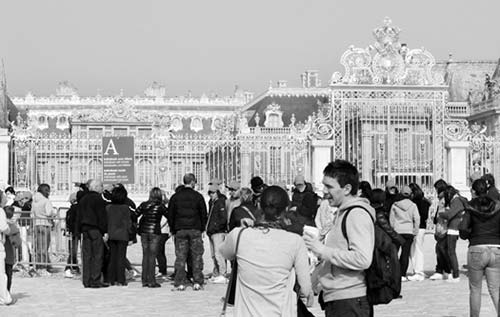
(See “Versailles Chateau” map, here.)
• Stand in the huge courtyard and face the palace. The golden Royal Gate in the center of the courtyard—nearly 260 feet long and decorated with 100,000 gold leaves—is a replica of the original. The ticket-sales office is to the left; guided-tour sales are to the right. The entrance to the Château (once you have your ticket or pass) is marked Entrance A (where the line usually is). Before entering (or while standing in line at the entrance), take in the Château and the open-air courtyard on the other side of the golden Royal Gate.
The section of the palace with the clock is the original château, once a small hunting lodge where little Louis XIV spent his happiest boyhood years. Naturally, the Sun King’s private bedroom (the three arched windows beneath the clock) faced the rising sun. The palace and grounds are laid out on an east-west axis.
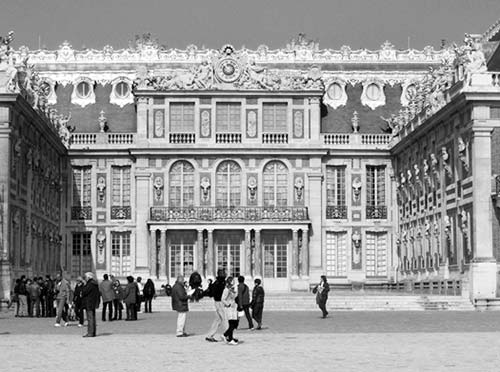
Once king, Louis XIV expanded the lodge by attaching wings, creating the present U-shape. Later, the long north and south wings were built. The total cost of the project has been estimated at half of France’s entire GNP for one year.
Think how busy this courtyard must have been 300 years ago. As many as 5,000 nobles were here at any one time, each with an entourage. Riding in sedan-chair taxis, they’d buzz from games to parties to amorous rendezvous. Servants ran about delivering secret messages and roast legs of lamb. Horse-drawn carriages arrived at the fancy gate with their finely dressed passengers, having driven up the broad boulevard that ran directly from Paris (the horse stables still line the boulevard). Incredible as it seems, both the grounds and most of the palace were public territory, where even the lowliest peasants could come to gawk—provided they passed through a metal detector and followed a dress code. Then, as now, there were hordes of tourists, pickpockets, palace workers, and men selling wind-up children’s toys.
• As you finally enter the Château, you’ll find an information desk (get a map), bag check, and WCs. Follow the crowds directly across the courtyard, where you’ll go back inside and line up for your free audioguide. While you may be tempted to save time by skipping your free audioguide, it’s worth the short extra wait. Now make your way to the start of our tour.
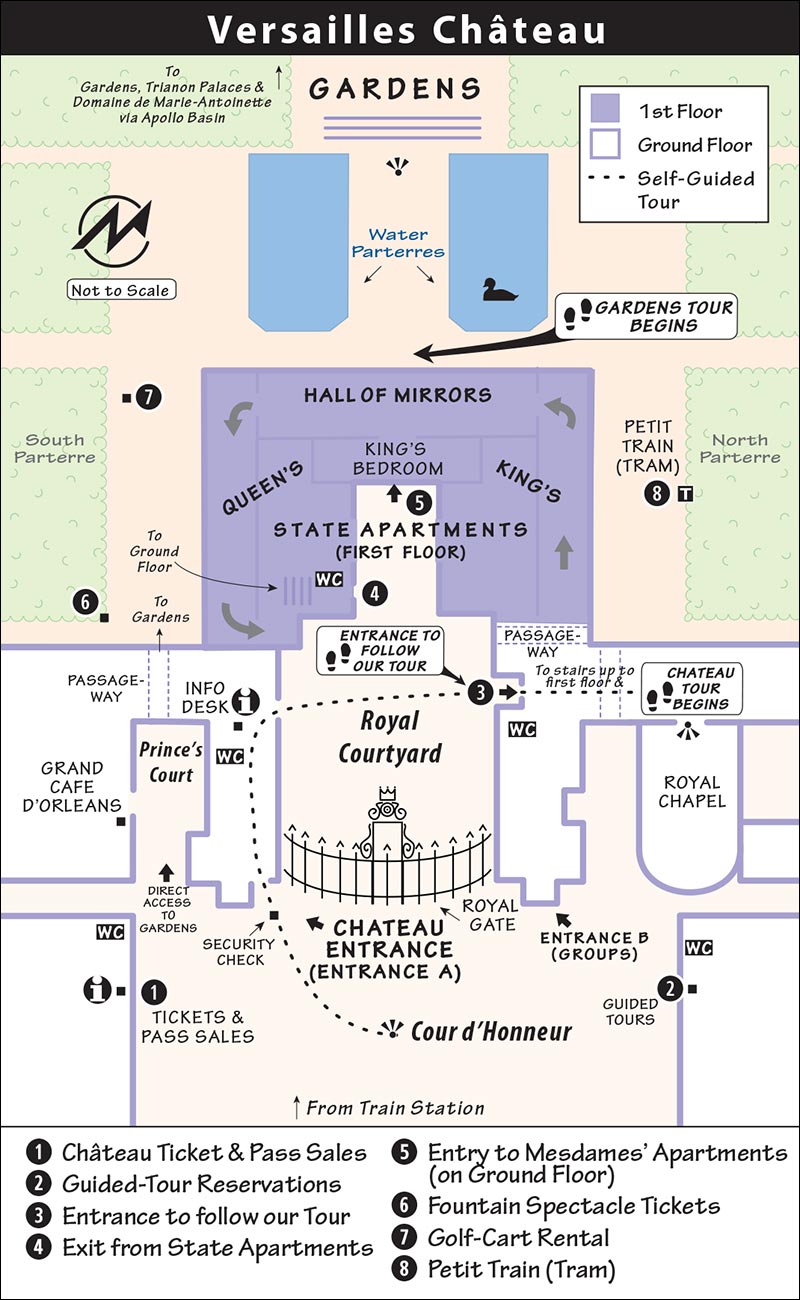
On the way to our tour’s first stop, the route passes through a dozen ground-floor rooms. The first offers a glimpse through a doorway at the impressive Royal Chapel, which we’ll see again upstairs. You’ll see rooms with paintings of Louis XIV, XV, and XVI, and models of Versailles at different stages of growth. As you go through these rooms, enjoy how the paintings give you a sense of court life at Versailles. There’s also a fine model of the grounds—handy for plotting your garden adventures after the palace. Climb the stairs, then wander through a series of rooms filled with portraits of long-forgotten VIPs. These lead to a palatial golden-brown room, with a doorway that overlooks the Royal Chapel. Let the tour begin.
Dut-dutta-dah! Every morning at 10:00, the organist and musicians struck up the music, these big golden doors opened, and Louis XIV and his family stepped onto the balcony to attend Mass. While Louis looked down on the golden altar, the lowly nobles on the ground floor knelt with their backs to the altar and looked up—worshipping Louis worshipping God. Important religious ceremonies took place here, including the marriage of young Louis XVI to Marie-Antoinette.
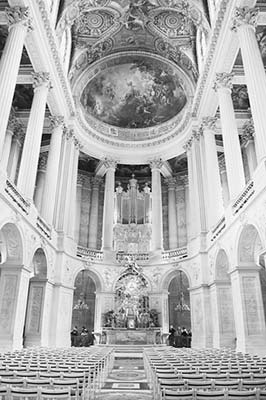
In the vast pagan “temple” that is Versailles—built to glorify one man, Louis XIV—this Royal Chapel is a paltry tip of the hat to that “other” god...the Christian one. It’s virtually the first, last, and only hint of Christianity you’ll see in the entire complex. Versailles celebrates Man, not God, by raising Louis XIV to almost godlike status, the personification of all good human qualities. In a way, Versailles is the last great flowering of Renaissance humanism and a revival of the classical world.
• Enter the next room, an even more sumptuous space with a fireplace and a colorful painting on the ceiling.
Pleasure ruled. The main suppers, balls, and receptions were held in this room. Picture elegant partygoers in fine silks, wigs, rouge, lipstick, and fake moles (and that’s just the men) as they dance to the strains of a string quartet.

On the wall opposite the fireplace is an appropriate painting showing Christ in the middle of a Venetian party. The work—by Paolo Veronese, a gift from the Republic of Venice—was one of Louis XIV’s favorites, so the king had the room decorated around it. Stand by the fireplace for the full effect: The room’s columns, arches, and frieze match the height and style of Veronese’s painted architecture, which makes the painting an extension of the room.
The ceiling painting, ringed by a balustrade, creates the effect of a sunroof opening up to heaven. Hercules (with his club) hurries up to heaven on a chariot, late for his wedding to the king of the gods’ daughter. The scene echoes real life—Louis XIV built the room for his own daughter’s wedding reception. The style is pure Baroque, a riot of 142 exuberant figures depicted at all angles by Louis’ court painter, Charles Le Brun.

• From here on it’s a one-way tour—getting lost is not allowed. Follow the crowds into the small green room with a goddess in pink on the ceiling. The names of the rooms generally come from the paintings on the ceilings. Some rooms are dark, making it hard to read. Saddle up to a window and pull the curtain a bit to find light.
If the party in the Hercules Room got too intense, you could always step in here for some refreshments. Silver trays were loaded with liqueurs, exotic stimulants (coffee), juice, chocolates, and, on really special occasions, three-bean salad.
The ceiling painting shows the cornucopia of riches poured down on invited guests.
Around the edges of the ceiling are painted versions of the king’s actual treasures and royal dinnerware—golden bowls, urns, and gravy boats. The two black chests of drawers are from Louis’ furniture collection (most of it was lost in the Revolution). They rest on heavy bases and are heavily ornamented—the so-called Louis XIV style.
Louis himself might be here. He was a gracious host who enjoyed letting his hair down at night. If he took a liking to you, he might sneak you through those doors there (in the middle of the wall) and into his own private study, or “cabinet of curiosities,” where he’d show off his collection of dishes, medals, jewels, or...the Mona Lisa, which hung on his wall. Louis’ favorite show-and-tell items are now in the Louvre.
The paintings on the walls are of Louis XIV’s heirs. He reigned for more than 70 years and outlived three of them, finally leaving the crown to his pink-cheeked, five-year-old great-grandson, Louis XV (on the right).
Love ruled at Versailles. In this room, couples would cavort beneath the goddess of love, floating on the ceiling. Venus sends down a canopy of golden garlands to ensnare mortals in delicious amour. Another ceiling painting (above the statue, in a rectangular frame) symbolizes the marriage of Louis XIV and Marie-Thérèse, shown in their wedding-limo chariot.
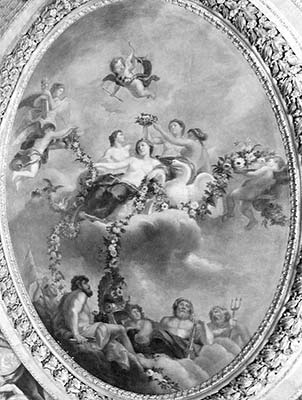
Baroque artists loved to mix their media to fool the eye. Notice how in the paintings at both ends of the room, the painted columns match the room’s real ones, extending this grand room into mythical courtyards.
Don’t let the statue of a confident Louis XIV as a Roman emperor fool you. He started out as a poor little rich kid with a chip on his shoulder. His father died before Louis was old enough to rule, and, during the regency period, the French parlements treated little Louis and his mother like trash. They were virtual prisoners, humiliated in their home, the Royal Palace in Paris (today’s Louvre). There they eked by with bland meals, hand-me-down leotards, and pointed shoes. After Louis XIV attained power and wealth, he made Versailles a pleasure palace, with happy hours held in this room every evening. There was one topic you never discussed in Louis’ presence: poverty. Maybe Versailles was his way of saying, “Living well is the best revenge.”
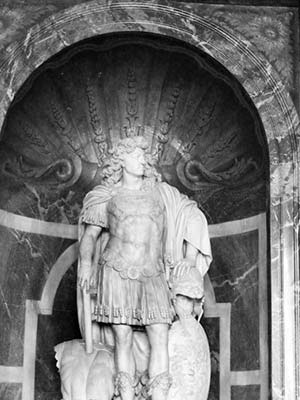
Here in the billiards room, Louis and his men played on a table that stood in the center of the room, while ladies sat surrounding them on Persian-carpet cushions, and music wafted in from next door. Louis was a good pool player, a sore loser, and a king—thus, he rarely lost.
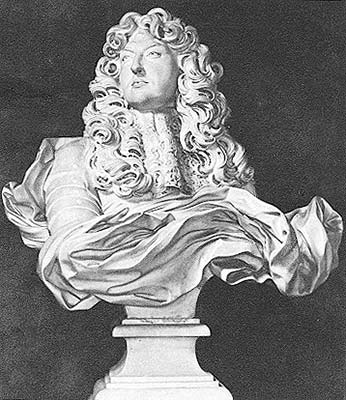
The famous bust of Louis by Giovanni Lorenzo Bernini (in the center) shows a handsome, dashing, 27-year-old playboy-king. His gaze is steady amid his windblown cloak and hair. Young Louis loved life. He hunted animals by day (notice Diana the Huntress, with her bow, on the ceiling) and chased beautiful women at night.
Games were actually an important part of Louis’ political strategy, known as “the domestication of the nobility.” By distracting the nobles with the pleasures of courtly life, he was free to run the government his way. Billiards, dancing, and concerts were popular, but the biggest distraction was gambling, usually a card game similar to blackjack. Louis lent money to the losers, making them even more indebted to him. The good life was an addiction, and Louis kept the medicine cabinet well-stocked.
As you move into the next room, notice the fat walls that hid thin servants, who were to be at their master’s constant call—but out of sight when not needed.
Also known as the Guard Room (as it was the room for Louis’ Swiss bodyguards), this red room is decorated with a military flair. On the ceiling there’s Mars, the Greek god of war, in a chariot pulled by wolves. The bronze cupids in the corners are escalating from love arrows to heavier artillery. But it’s not all war. Louis loved music and playing his guitar, and enjoyed concerts here in the Mars Room nearly every evening.
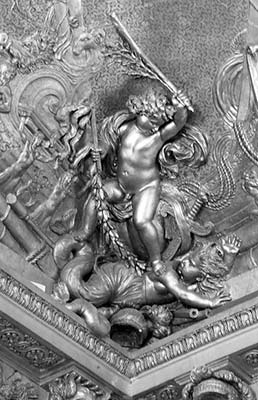
Out the window are sculpted gardens in the style of a traditional Italian villa—landscaped symmetrically, with trimmed hedges and cone-shaped trees lining walkways that lead to fountains.
As you wander, you’ll notice that the palace feels bare, but remember that entire industries were created to decorate the place with carpets, mirrors, furniture, and tapestries. Most of the furniture we see today is not original, but is from the same period.
Louis’ life was a work of art, and Versailles was the display case. Everything he did was a public event designed to show his subjects how it should be done. This room may have served as Louis’ official (not actual) bedroom, where the Sun King would ritually rise each morning to warm his subjects.
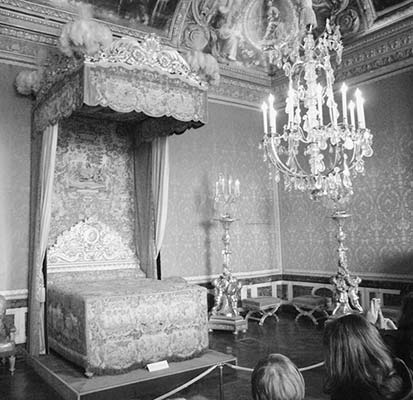
From a canopied bed (like this 18th-century one), Louis would get up, dress, and take a seat for morning prayer. Meanwhile, the nobles would stand behind a balustrade, in awe of his piety, nobility, and clean socks. At breakfast, they murmured with delight as he deftly decapitated his boiled egg with a knife. And when Louis went to bed at night, the dukes and barons would fight over who got to hold the candle while he slipped into his royal jammies. Bedtime, wake-up, and meals were all public rituals.
This was the grand throne room. Louis held court from a 10-foot-tall, silver-and-gold, canopied throne on a raised platform placed in the center of the room (the platform is there, though not the throne). Even when the king was away, passing courtiers had to bow to the empty throne.
Everything in here reminds us that Louis XIV was not just any ruler, but the Sun King, who lit the whole world with his presence. On the ceiling, the sun god Apollo (representing Louis) drives his chariot, dragging the sun across the heavens to warm the four corners of the world (counterclockwise from above the exit door): 1) Europe, with a sword; 2) Asia, with a lion; 3) Africa, with an elephant; and 4) good ol’ America, an Indian maiden with a crocodile. Notice the ceiling’s beautifully gilded frame and Goldfinger maidens.
The famous portrait by Hyacinthe Rigaud over the fireplace gives a more human look at Louis XIV. He’s shown in a dancer’s pose, displaying the legs that made him one of the all-time dancing fools of kingery (see a photo of this portrait on here). At night, they often held parties in this room, actually dancing around the throne.
Louis XIV (who was 63 when this was painted) had more than 300 wigs like this one, and he changed them many times a day. This fashion first started when his hairline began to recede, then sprouted all over Europe, and even spread to the American colonies in the time of George Washington.
Louis XIV may have been treated like a god, but he was not an overly arrogant man. His subjects adored him because he was a symbol of everything a man could be, the fullest expression of the Renaissance Man. Compare the portrait of Louis XIV with the one across the room of his last successor, Louis XVI—same arrogant pose, but without the inner confidence to keep his head on his shoulders.
• Continue into the final room of the King’s Wing.
“Louis Quatorze was addicted to wars,” and the room depicts his victories—in marble, gilding, stucco, and paint. France’s success made other countries jealous and nervous. At the base of the ceiling (in semicircular paintings), we see Germany (with the double eagle), Holland (with its ships), and Spain (with a red flag and roaring lion) ganging up on Louis XIV. But Lady France (center of ceiling), protected by the shield of Louis XIV, hurls thunderbolts down to defeat them. The stucco relief on the wall shows Louis XIV on horseback, triumphing over his fallen enemies.

Versailles was good propaganda. It showed the rest of the world how rich and powerful France was. A visit to the Château and Gardens sent visitors reeling. And Louis XIV’s greatest triumph may be the next room, the one that everybody wrote home about.
No one had ever seen anything like this hall when it was opened. Mirrors were still a great luxury at the time, and the number and size of these monsters was astounding. The hall is nearly 250 feet long. There are 17 arched mirrors, matched by 17 windows letting in that breathtaking view of the Gardens. Lining the hall are 24 gilded candelabra, eight busts of Roman emperors, and eight classical-style statues (seven of them ancient). The ceiling decoration chronicles Louis’ military accomplishments, topped off by Louis himself in the central panel (with cupids playing cards at his divine feet) doing what he did best—triumphing. Originally, two huge carpets mirrored the action depicted on the ceiling.

Imagine this place lit by the flames of thousands of candles, filled with ambassadors, nobles, and guests dressed in silks and powdered wigs. At the far end of the room sits the king, on the canopied throne moved in temporarily from the Apollo Room. Servants glide by with silver trays of hors d’oeuvres, and an orchestra fuels the festivities. The mirrors reflect an age when beautiful people loved to look at themselves. It was no longer a sin to be proud of good looks and fine clothes, or to enjoy the good things in life: laughing, dancing, eating, drinking, flirting, and watching the sun set into the distant canal.
From the center of the hall you can fully appreciate the epic scale of Versailles. The huge palace (by architect Louis Le Vau), the fantasy interior (by Charles Le Brun), and the endless gardens (by André Le Nôtre) made Versailles le best. In 1871, after the Prussians defeated the French, Otto von Bismarck declared the establishment of the German Empire in this room. And in 1919, Germany and the Allies signed the Treaty of Versailles, ending World War I (and, some say, starting World War II) right here, in the Hall of Mirrors.
• Midway down the Hall of Mirrors, you’ll be routed to the left through the heart of the palace, to the...
Pass through a first large room to find Louis XIV’s bedroom. It’s elaborately decorated, and the decor changed with the season. On the wall behind the impressive bed, a golden Lady France watched over her king as he slept. The balustrade separated the courtiers from the king. Though this was Louis’ actual bedroom, it was also a somewhat public space where he received visitors. The two rooms on either side of the bedroom—right next to where the king slept—were large halls for ambassadorial receptions and cabinet meetings.

Look out the window and notice how this small room is at the exact center of the immense horseshoe-shaped building, overlooking the main courtyard and—naturally—facing the rising sun in the east. It symbolized the exact center of power in France. Imagine the humiliation on that day in 1789 when Louis’ great-great-great-grandson, Louis XVI, was forced to stand here and acknowledge the angry crowds that filled the square demanding the end of the divine monarchy.
• The Queen’s Wing of the Château is closed for extensive renovation, so from here you’ll walk through several unremarkable rooms as you make your way downstairs to the exit. This ends our tour of the Château, but there is more, all described in the included audioguide.
On the first floor, there are the History of France rooms, temporary exhibits, and the Salon de Thé Angelina (which serves decadent hot chocolate and their Mont Blanc—a chestnut-cream meringue with whipped cream).
On the ground floor, you could see the fancy Mesdames’ Apartments—the rooms set aside for the six daughters of Louis XV. You’ll eventually reach the audioguide-return desk. Note that the security zone border and checked bag pick-up are within about 10 steps. Once you turn in your audioguide, you’ll pass security and enter the Gardens (if you later want to return to the palace, you’ll need to go through security again).
Exit the palace and follow signs to the Gardens (les Jardins), located behind the Château.
Now might be a good time to break for lunch (I prefer lunch in the Gardens—see here for options).
Louis XIV was a divine-right ruler. One way he proved it was by controlling nature like a god. These lavish grounds—elaborately planned, pruned, and decorated—showed everyone that Louis was in total command. Louis loved his gardens and, until his last days, presided over their care. He personally led VIPs through them and threw his biggest parties here. With their Greco-Roman themes and incomparable beauty, the Gardens further illustrated his immense power.
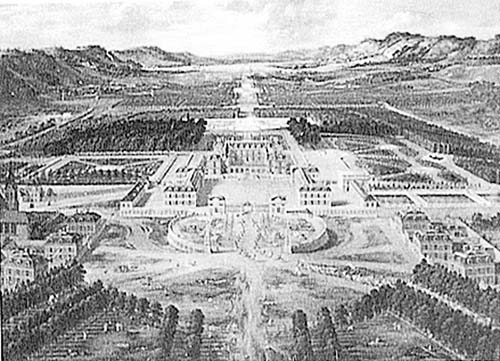
The Gardens are vast. For some, a stroll through the landscaped shrubs around the Château and quick view down the Royal Drive is plenty. But it’s worth the 10-minute walk down the Royal Drive to the Apollo Basin and back (even if you don’t continue further to the Trianon/Domaine).
• Entering the Gardens, make your way farther into the king’s spacious backyard. You pass by artificial ponds, reclining river-god statues, and cookie-cutter patterns of shrubs and green cones. As you walk, consider that a thousand orange trees were once stored beneath your feet in greenhouses. On sunny days, they were wheeled out in their silver planters and scattered around the grounds. The warmth from the Sun King was so great that he could even grow orange trees in chilly France.
You soon reach the top step of a staircase overlooking the Gardens. Face away from the palace and take in the jaw-dropping...
This, to me, is the most stunning spot in all of Versailles. With the palace behind you, it seems as if the grounds stretch out forever. Versailles was laid out along an eight-mile axis that included the grounds, the palace, and the town of Versailles itself, one of the first instances of urban planning since Roman times and a model for future capitals, such as Washington, DC and Brasilia.
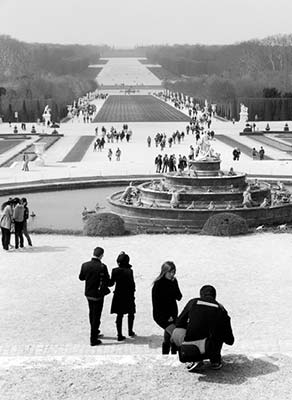
Looking down the Royal Drive (also known as “The Green Carpet”), you see the round Apollo fountain in the distance. Just beyond that is the Grand Canal. The groves on either side of the Royal Drive were planted with trees from all over, laid out in an elaborate grid, and dotted with statues and fountains. Of the original 1,500 fountains, 300 remain.
Looking back at the palace, you can see the Hall of Mirrors—it’s the middle story, with the arched windows.
• Stroll down the steps to get a good look at the frogs and lizards that fill the round...
Everything in the garden has a symbolic meaning. The theme of Versailles is Apollo, the god of the sun, associated with Louis XIV. This round fountain tells the story of the birth of Apollo and his sister, Diana. On top of the fountain are Apollo and Diana as little kids with their mother, Latona (they’re facing toward the Apollo fountain). Latona, an unwed mother, was insulted by the local peasants. She called on the king of the gods, Zeus (the children’s father), to avenge the insult. Zeus swooped down and turned all the peasants into the frogs and lizards that ring the fountain.
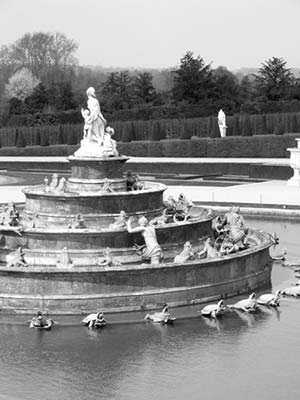
• As you walk down past the basin toward the Royal Drive, you’ll pass by “ancient” statues done by 17th-century French sculptors. You’ll see statues of gods, nymphs, mythological heroes, allegories of the seasons, and huge Roman-style vases. A cheap café and WCs are close by. The Colonnade is hidden in the woods on the left side of the Royal Drive, about three-fourths of the way to the Apollo Basin (you’ll spot it off the main path through an opening).
Versailles had no prestigious ancient ruins, so the king built his own. This prefab Roman ruin is a 100-foot circle of 64 red-marble columns supporting pure-white arches. The arches are decorated with cherubs playing harps. In the center stands a statue of Pluto (Greek god of the Underworld) carrying off Proserpine while her mom gets trampled. Surrounding the whole thing are small birdbath fountains (imagine them all spouting water). Nobles would picnic in the shade to the tunes of a string quartet and pretend that they were the enlightened citizens of the ancient world.
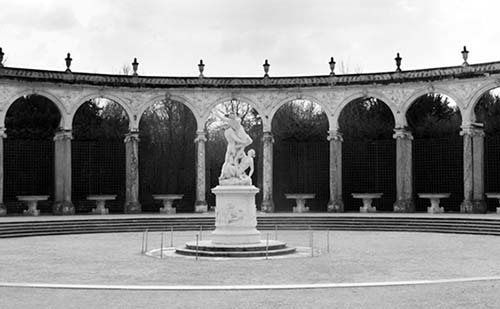
The fountains of Versailles were once its most famous attraction, a marvel of both art and engineering. This one was the centerpiece, showing the sun god—Louis XIV—in his sunny chariot as he starts his journey across the sky. The horses are half-submerged, giving the impression, when the fountains play, of the sun rising out of the mists of dawn. Apollo’s entourage includes dolphins leading the way and Tritons blowing their conch shells. Most of the fountains were turned on only when the king walked by, but this one played constantly for the benefit of those watching from the palace. Look into the water to see the substantial pipes that feed this powerful fountain.
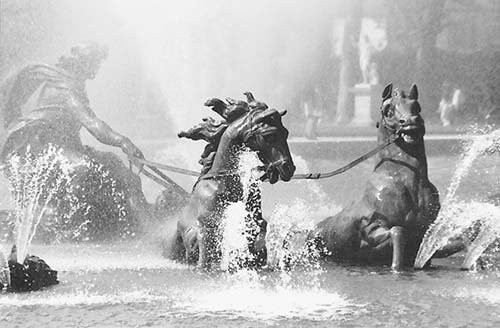
All the fountains are gravity-powered. They work on the same principle as blocking a hose with your finger to make it squirt. Underground streams (pumped into Versailles by Seine River pressure) feed into smaller pipes at the fountains, which shoot the water high into the air.
Looking back at the palace from here, realize that the distance you just walked is only a fraction of this vast complex of buildings, gardens, and waterways. Be glad you don’t have to mow the lawn.
Why visit Venice when you can just build your own? In an era before virtual reality, this was the next best thing to an actual trip. Couples in gondolas would pole along the waters accompanied by barges with orchestras playing “O Sole Mio.” The canal is actually cross-shaped; you’re looking at the longest part, one mile from end to end. Of course, this, too, is a man-made body of water with no function other than to please. Originally, authentic gondoliers, imported with their boats from Venice, lived in a little settlement next to the canal.

These days, the Grand Canal hosts eateries, rental boats, bike and golf-cart rentals, and a petit train tram stop (see sidebar on here).
• The area called the Trianon Palaces and Domaine de Marie-Antoinette is a 10-minute walk from the Grand Canal. You can enter/exit the Trianon/Domaine at three spots: near the palace known as the Grand Trianon (where we’ll enter), near the Petit Trianon palace, or way around back on the far side of the Hamlet.
If you’re monitoring your time and energy, note that it’s a 1.5-hour time commitment to see the whole Trianon/Domaine, plus a 30-minute walk back to the Château. You can take a bike, golf cart, or petit train as far as the entrance, but you have to walk inside.
To get to our tour’s starting point, the Grand Trianon, veer right just past the restaurants and boat rental (see the map on here) and follow the dirt path along a looooong strip of lawn. This leads uphill 500 yards to the Grand Trianon. (Bikers/golf-cart drivers can park their wheels here.)
(See “Domaine de Marie-Antoinette” map, here.)
Versailles began as an escape from the pressures of kingship. But in a short time, the Château became as busy as Paris ever was. Louis XIV needed an escape from his escape, so he built a smaller palace out in the boonies. Later, his successors retreated still farther from the Château and French political life, ignoring the real world that was crumbling all around them. They expanded the Trianon area, building a fantasy world of palaces, ponds, pavilions, and pleasure gardens—the enclosure called Marie-Antoinette’s Domaine. Today, the Trianon/Domaine is a walled-off part of the Gardens accessible only with a ticket.

If you’re heading back to Paris from here, note that the TRI bus to Versailles Château Rive Gauche train station leaves from near the Trianon buildings at :08 after the hour (see map on the next page).
• Enter the Grand Trianon and pass through its security checkpoint. Pick up the free palace brochure and follow the simple one-way route through the rooms. Read your flier as you follow this tour to get the most out of your visit.
Delicate, pink, and set amid gardens, the Grand Trianon was the perfect summer getaway. This was the king’s private residence away from the main palace. Louis XIV usually spent a couple of nights a week here (more in the summer) to escape the sniping politics, strict etiquette, and 24/7 scrutiny of official court life.

Louis XIV built the palace (1670-1688) near the tiny peasant village of Trianon (hence the name) and faced it with blue-and-white ceramic tiles. When those began disintegrating almost immediately, the palace was renovated with pink marble. It’s a one-story structure of two wings connected by a colonnade, with gardens in back.
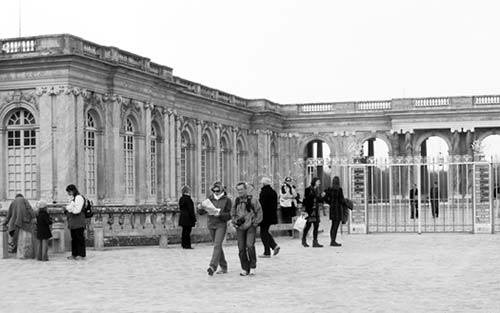
The rooms are a complex overlay of furnishings from many different kings, dauphins, and nobles who lived here over the centuries. Louis XIV alone had three different bedrooms. Concentrate on the illustrious time of Louis XIV (1688-1715) and Napoleon Bonaparte (1810-1814). Use your map (which has room numbers on it) to find these highlights.
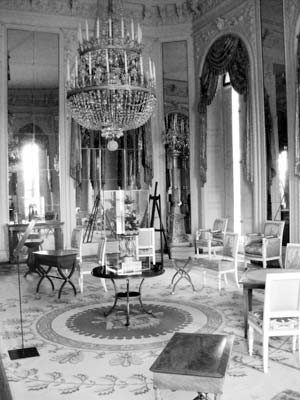
Mirror Room (Salon des Glaces): This spacious living room has the original white walls and mirrors of Louis XIV, and the Empire-style furniture of Napoleon (unornamented, high-polished wood, with classical motifs). Napoleon inhabited the Grand Trianon with his second wife, Empress Marie-Louise, and his mother—the women in the left wing, the emperor in the right.

Louis XIV’s Bedroom (Chambre de l’Impératice): Louis built the Grand Trianon as home for his chief mistress, while his wife lived in the Château. Imagine waking up in this big bed with your lover, throwing back the curtain, and looking out the windows at the gardens. These light, airy, many-windowed rooms were cheery even when skies were gray, a strong contrast to the heavy-metal decor in the mother Château.
Exit into the open-air colonnade (Peristyle) that connects the two wings. Originally, this pink-columned passageway had windows, an enormously expensive luxury that allowed visitors to enjoy the gardens even in bad weather.
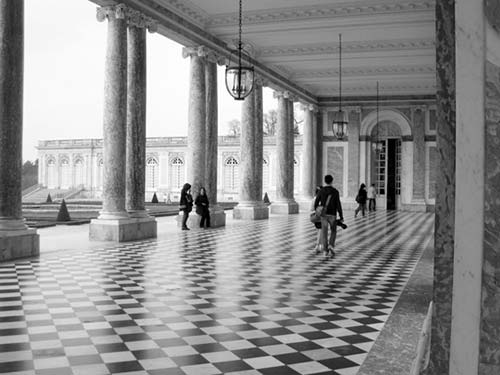
Emperor’s Family Drawing Room (Salon de Famille de l’Empereur): This room, immediately to your right upon entering, had many different uses over the years: a theater for Louis XIV, a game room for Louis XV, and Napoleon’s family room. After Napoleon was defeated and France’s royalty returned, King Louis-Philippe I lived here. Walk through a series of rooms, passing through Louis-Philippe’s billiards room, until you reach a room decorated in green malachite.
Malachite Room (Salon des Malachites): This was Napoleon’s living room, and his library was next door. You’ll see the impressive green basin, vases, and candelabras made of Russian malachite given to Napoleon by Czar Alexander I. Another czar, Peter the Great, who lodged in the Grand Trianon in 1717 and then returned home, was inspired to build the Peterhof—a similarly lavish summer palace near St. Petersburg known as the “Russian Versailles.”
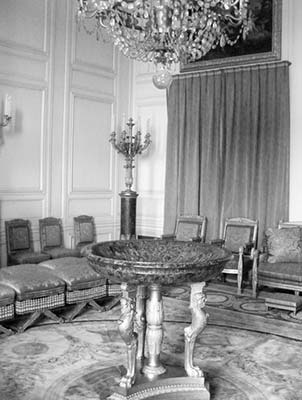
Cotelle Gallery (Galerie Cotelle): This white, 170-foot-long room was Louis’ reception hall. Later, Marie-Antoinette performed here in theatrical productions for select audiences. The gallery is interspersed with big French doors and lined with paintings of Versailles vistas, peopled by promenading aristocrats. Party guests could admire the gardens in the paintings, then step out into the real thing.
Exit into the gardens and look back. The facade of pink, yellow, and white is a welcome contrast to the imposing Baroque facade of the main palace. The flower gardens were changed daily for the king’s pleasure—for new color combinations and new “nasal cocktails.”
• Our next stop is the French Pavilion. To get there from the Grand Trianon gardens, walk clockwise around the perimeter of the Grand Trianon. Make it a tight, 180-degree loop, hugging the palace. A sign will direct you across a footbridge. Directly ahead, you’ll see the...
This small, white building (generally closed) with rooms fanning out from the center was one more step away from the modern world. Inside is a circular room with four small adjoining rooms. Big French doors let in a cool breeze. Here Marie-Antoinette spent summer evenings with family and a few friends, listening to music or playing parlor games. She and her friends explored all avenues of la douceur de vivre, the sweetness of living.
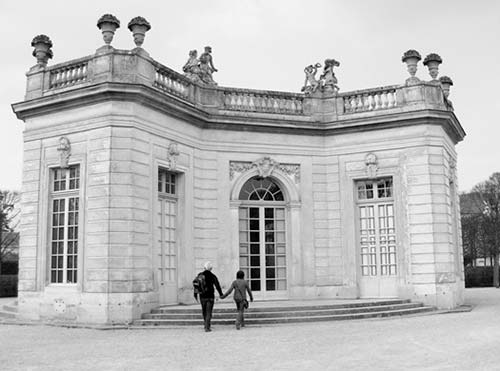
• Up ahead is the large, cube-shaped Petit Trianon palace—that’s where our tour will eventually end. Head toward the Petit Trianon, but midway there, turn left, where you can peek into...
Marie-Antoinette adored the theater and was an aspiring performer herself. In this intimate playhouse, far from the rude intrusions of the real world, the queen and her friends acted out plays. The soft blue decor and upholstered walls and benches give the theater a dollhouse feel. Though small, it has everything you’d find in a major opera house: stage, orchestra pit, balconies, ornate gold ceiling, and raked seating for 100.
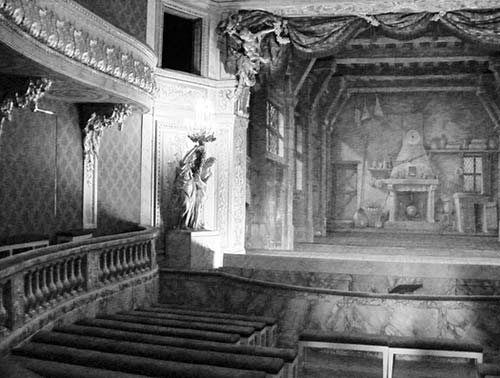
• Continue through the oh-so-bucolic gardens until just before the Petit Trianon. Turn left and follow paths uphill to a pond graced with a tiny palace.
The octagonal Belvedere palace is as much windows as it is walls. When the doors were open, it could serve as a gazebo for musicians, serenading nobles in this man-made alpine setting. The interior has a marble-mosaic floor and walls decorated with delicate, Pompeii-esque garlands. To the left of the Belvedere is the “Rock,” a fake mountain that pours water into the pond. To the right of the Belvedere (you’ll have to find it) is the secret Grotto.
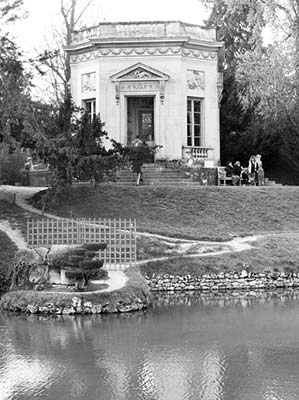
• Facing the Belvedere, turn right (east), following the pond’s meandering stream. Continue gamboling along the paths. In the distance you’ll spy a complex of buildings, with a round, fanciful tower and a smattering of rustic, half-timbered buildings. Head there to find the Hansel-and-Gretel-like...
Marie-Antoinette longed for the simple life of a peasant—not the hard labor of real peasants, who sweated and starved around her, but the fairytale world of simple country pleasures. She built this complex of 12 thatched-roof buildings fronting a lake as her own private “Normand” village.
The main building is the Queen’s House—actually two buildings connected by a wooden skywalk. It’s the only one without a thatched roof. Like any typical peasant farmhouse, it had a billiard room, library, elegant dining hall, and two living rooms.
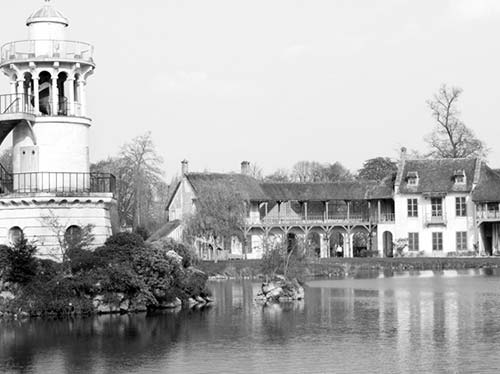
This was an actual working farm with a dairy (walk past the lighthouse tower), a water mill, a pigeon coop (in a thatched cottage called Le Colombier), and domestic animals. Beyond the lighthouse tower (La Tour de Marlborough—departure point for boat trips on the pond), you’ll see where the queen’s servants kept cows, goats, chickens, and ducks. The harvest was served at Marie-Antoinette’s table. Marie-Antoinette didn’t do much work herself, but she “supervised,” dressed in a plain, white muslin dress and a straw hat. Though the royal family is long gone, kid-pleasing animals still inhabit the farm, and beaucoup fat fish swim languid circles in the pond.
• Head back toward the Petit Trianon. Along the way (in about five minutes), you’ll see the white dome of the...
A circle of 12 marble Corinthian columns supports a dome, decorating a path where lovers could stroll. Underneath there’s a statue of Cupid making a bow (to shoot arrows of love) out of the club of Hercules. It’s a delightful monument to a society where the rich could afford that ultimate luxury, romantic love.
• And, finally, you’ll reach the...
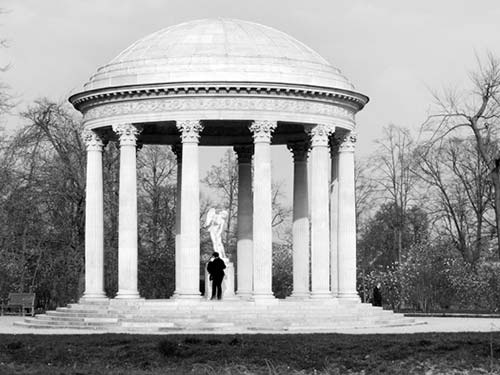
Louis XV developed an interest in botany. He wanted to spend more time near the French Gardens, but the Summer House just wasn’t big enough. He constructed the Petit Trianon (“Small Trianon”) at the urging of his first mistress, Madame de Pompadour, and it later became home to his next mistress, Madame du Barry.
This gray, cubical building is a masterpiece of Neoclassical architecture, built by the same architect who created the Opera House in the main palace. It has four distinct facades, each a perfect and harmonious combination of Greek-style columns, windows, and railings. Walk around it and find your favorite.

You can tour the handsome interior (pick up the helpful flier). English explanations are provided in some rooms, as are interactive screens. The Baroque WC was ahead of its time.
When Louis XVI became king, he gave the building to his bride Marie-Antoinette, who made this her home base. On the lawn outside, she installed a carousel. Despite her bad reputation with the public, Marie-Antoinette was a sweet girl from Vienna who never quite fit in with the fast, sophisticated crowd at Versailles. At the Petit Trianon, she could get away and re-create the charming home life that she remembered from her childhood. Here she played, while in the cafés of faraway Paris, revolutionaries plotted the end of the ancien régime.
• The main Château is a 30-minute walk straight out of the exit to the southeast (allow another 10 minutes to reach the train station). If you’ve had enough walking, you can ride the petit train from here back to the Château.
For a slightly shorter walk back to the train station, and a chance to see the Neptune Basin (an impressive miniature lake with fountains; see map on here), walk straight down from the Petit Trianon and turn left on Avenue de la Trianon (the gate here is closed before Spectacle shows). If you stay straight as an arrow, you’ll run into the Neptune Basin, where the grand finale takes place on fountain days. Leave Neptune at the far-left corner gate, and you’ll pop out onto Rue de la Paroisse, the town’s main shopping drag, which takes you into the market square. From here, a right on Avenue de l’Europe takes you to the train station and Train-C back to Paris.
Or, you can return from the Trianon/Domaine directly to Versailles Château Rive Gauche station by catching the TRI line shuttle bus (mid-April-Oct only, leaves at :08 after the hour, see map on here for stop and find details in the “Getting Around the Gardens” sidebar, earlier).
If Paris is your only stop in France, the town of Versailles gives an opportunity to enjoy a classic, small French town that doesn’t feel touristy. And, for a less expensive and more laid-back alternative to Paris, the town of Versailles can be a good overnight stop, especially for drivers. Park in the palace’s main lot while looking for a hotel, or leave your car there overnight (see here).
The pleasant town center—around Place du Marché Notre-Dame—hosts a thriving open market defined by four L-shaped halls. The two halls closest to the palace (Carre a la Maree and Carre a la Herbes, Tue-Sat 7:30-13:00 & 15:30-19:00, Sun 7:30-13:00, closed Mon) are worth a wander. The square itself hosts regular markets (food market Sun, Tue, and Fri mornings until 13:00; clothing market all day Wed-Thu and Sat). Nearby streets have a variety of reasonably priced restaurants, cafés, and shops.
$ Hôtel de France*** is in a 17th-century townhouse just outside the gates of the palace. It offers Old World class, mostly air-conditioned, traditional rooms with thick tapestries and rugs, a pleasant courtyard, a bar, and a restaurant (23 rooms, just off parking lot across from Château at 5 Rue Colbert, tel. 01 30 83 92 23, www.hotelfrance-versailles.com, hotel-de-france-versailles@wanadoo.fr).

$ Hôtel le Cheval Rouge,*** built in 1676 as Louis XIV’s stables, now boards tourists. Tucked into a corner of Place du Marché, this modest hotel has a big courtyard with free parking and sufficiently comfortable rooms connected by long halls (40 rooms, no air-con, 18 Rue André Chénier, tel. 01 39 50 03 03, www.chevalrougeversailles.fr, chevalrouge@sfr.fr).
$ Hôtel Ibis Versailles*** offers a good weekend value and modern comfort, with 85 air-conditioned rooms (good buffet breakfast open to public and served daily until 10:00; pay parking, across from train station at 4 Avenue du Général de Gaulle, tel. 01 39 53 03 30, www.ibishotel.com, h1409@accor.com).
(See “Versailles Town Hotels & Restaurants” map, here.)
The Place du Marché Notre-Dame market square—a 15-minute walk from the Château (veer left as you leave the Château)—is lined with colorful and inexpensive eateries with good seating inside and out. Troll the various options or try one of these:
$$$ Bistrot du Boucher reeks with fun character inside and has good seating outside. They like their meat dishes best here, though you’ll find a full menu of choices (bargain lunch menu, daily, 12 Rue André Chénier, tel. 01 39 02 12 15, Nolan).
$$ Au Chien qui Fume is a good choice, with cozy seating inside and out, a playful staff, and reliable, traditional cuisine (lunch deals, closed Sun, 72 Rue de la Paroisse, tel. 01 39 53 14 56).
$ La Boulangerie has mouthwatering sandwiches, salads, quiches, and more (Tue-Sat until 20:00, Sun until 13:30, closed Mon, 60 Rue de la Paroisse).
Breakfast: The Hôtel Ibis Versailles offers a good buffet breakfast (see listing, earlier).
Supermarket: A big Monoprix is centrally located between the Versailles Château Rive Gauche train station and Place du Marché Notre-Dame (entrances from Avenue de l’Europe and at 5 Rue Georges Clemenceau, Mon-Sat 8:30-21:00, closed Sun).